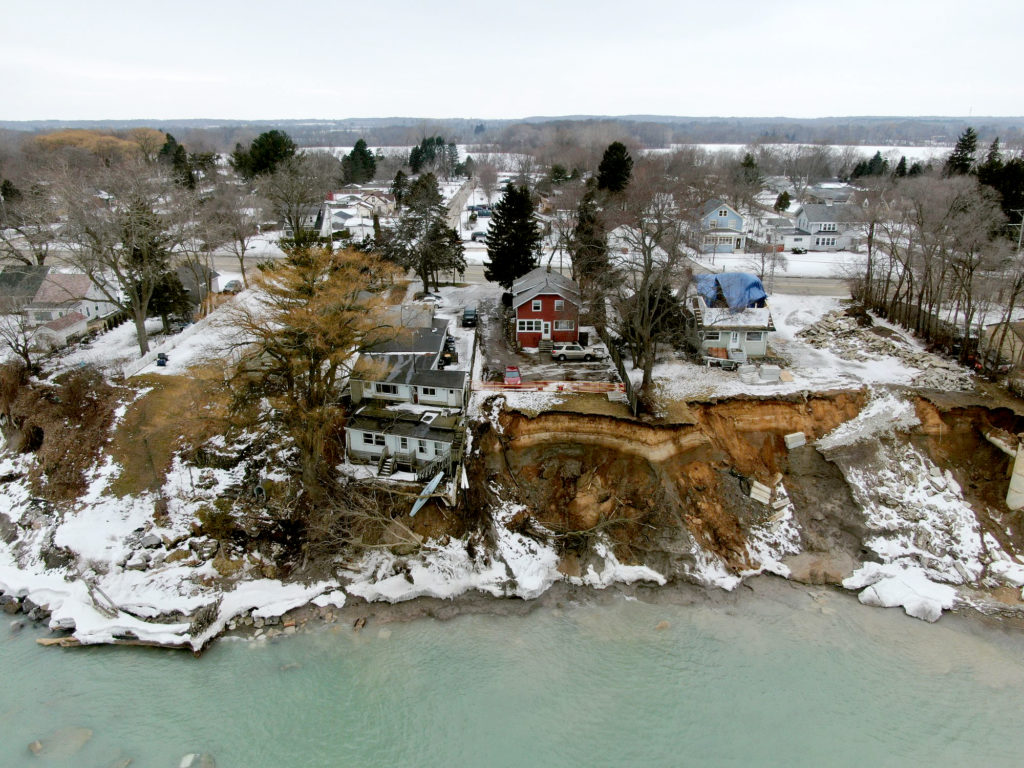
Erosion on the lakefront and 16th Pl. can be seen from the air. Photo courtesy of View from Above – Wisconsin.
Lakefront erosion has been an ongoing issue for Somers residents. Lake Michigan, being at historic high levels, has caused many issues for coastal residents. Tracking by the U.S. Army Corps of Engineers (see data and forecast) indicates that levels will remain at record levels through the first half of 2020.
The village of Somers will hold an informational meeting for residents. Multiple agencies and elected officials will be in attendance. The meeting will take place March 18, 2020. Find out more here.
The lakefront comes under multiple jurisdictions. At the federal level, the U.S. Army Corps of Engineers monitors the cumulative impact of existing and planned projects. It uses effective methods to evaluate the environmental as well as the economic impact of projects. It considers environmental stewardship in its role as a water protection agency, as well as an environmental regulator.
U.S. Army Corps of Engineers
In coastal regions, the U.S. Army Corps of Engineers’ primary roles include protecting and restoring habitat, maintaining navigable waters, conducting beach nourishment, undertaking flood control projects and regulating coastal restoration projects.
Erosion is under their jurisdiction, however, it is not an issue that the U.S. Army Corps of Engineers can address by emergency response. Bank stabilization requires approval through the application for Army Corp National Permit 13 for Bank Stabilization. The permit has a lot of requirements including:
- Minimum amount of material needed for erosion protection
- No more than 500 feet
- No more than one cubic yard of fill per lineal foot below ordinary high water mark
- No fill in wetlands (can be waived by Corp, after examination)
- Additional conditions apply
More information about the permit is available here.
Federal Emergency Management Agency
FEMA has initiated a coastal analysis and mapping study to produce updated Flood Insurance Rate Maps (FIRMs) for coastal counties along the Great Lakes.
There are other agencies that can help coastal residents, such as the the Wisconsin Sea Grant, based out of the University of Wisconsin – Madison and the Wisconsin DNR.
Information from Wisconsin Sea Grant
Wisconsin Sea Grant is a statewide program of basic and applied research, education, and outreach and technology transfer dedicated to the stewardship and sustainable use of the nation’s Great Lakes and ocean resources.
Contractors
Residents looking to have erosion control work done can find a partial list of known firms that have completed projects on Lake Michigan or Lake Superior. This list is for information only and is not a list of “approved” or “recommended” firms.
- Great Lakes coastal engineering firms and contractors
- Wisconsin Building Movers Association
- International Association of Structural Movers
Wisconsin Department of Natural Resources
Placing shoreline erosion control along a Great Lakes shoreline often requires a state individual permit. An exemption from permitting may be available along certain shorelines. Below you will find information to help you determine whether the shoreline erosion control exemption applies to your property and also information to aid in the submittal of a permit application should one be required. You can learn about the permit types and timeframes for a permit review here.
You can find state erosion control permitting information at the following web links:
- DNR’s homepage
- Shoreline erosion control exemption checklist
- Designated waters viewer to determine whether you are located in an ASNRI
- Specific Great Lakes lakeshore erosion control info
- General information for lakeshore projects
- Start the application process at this link.
- Energy calculation worksheet
Links to these forms: